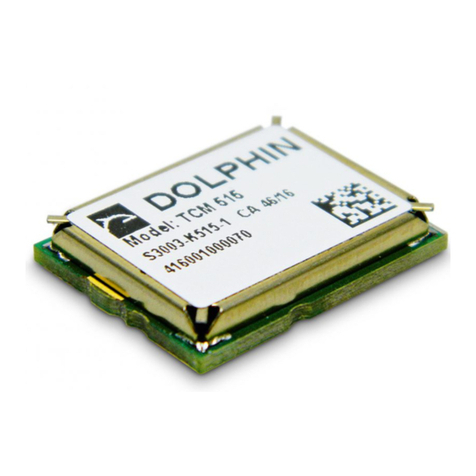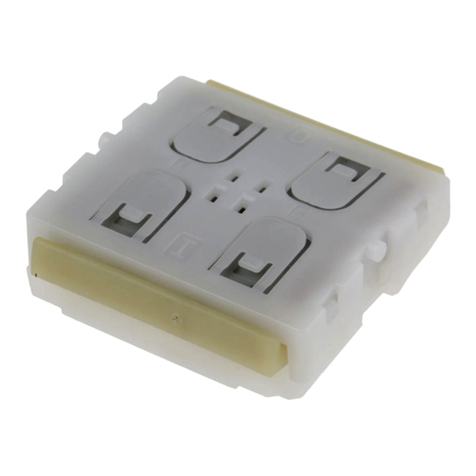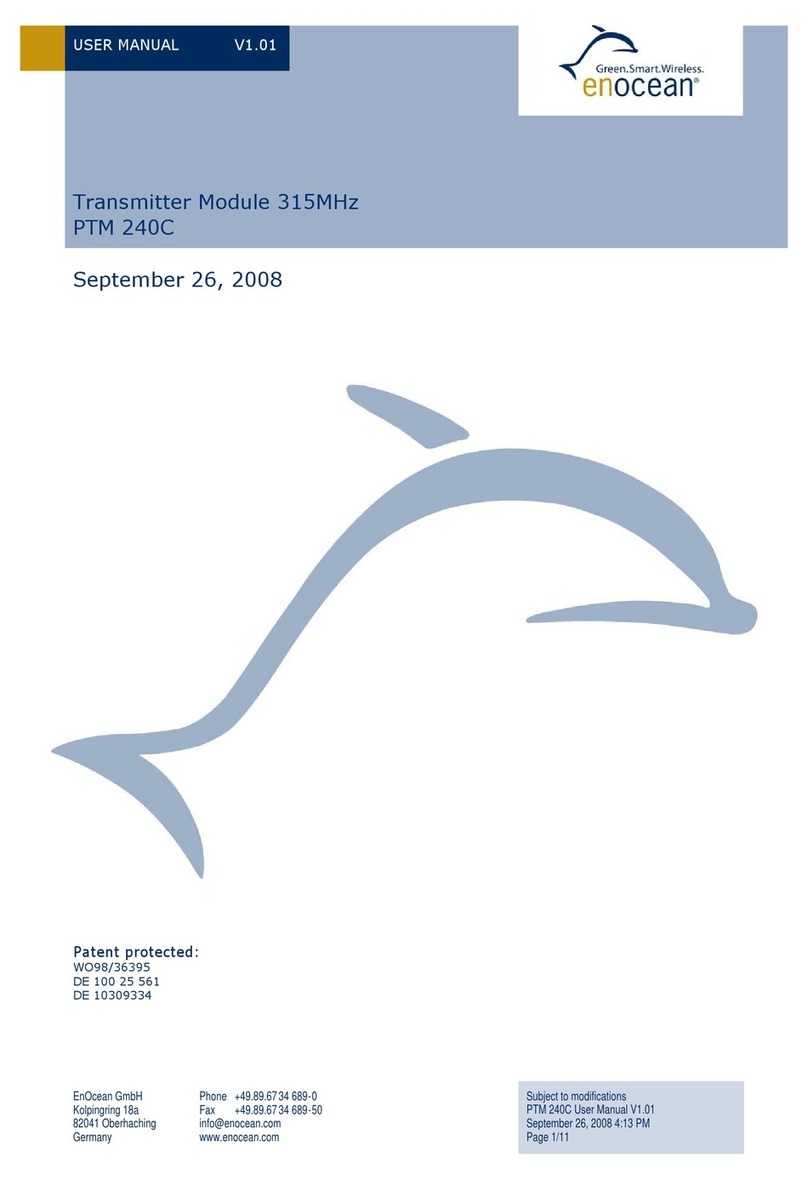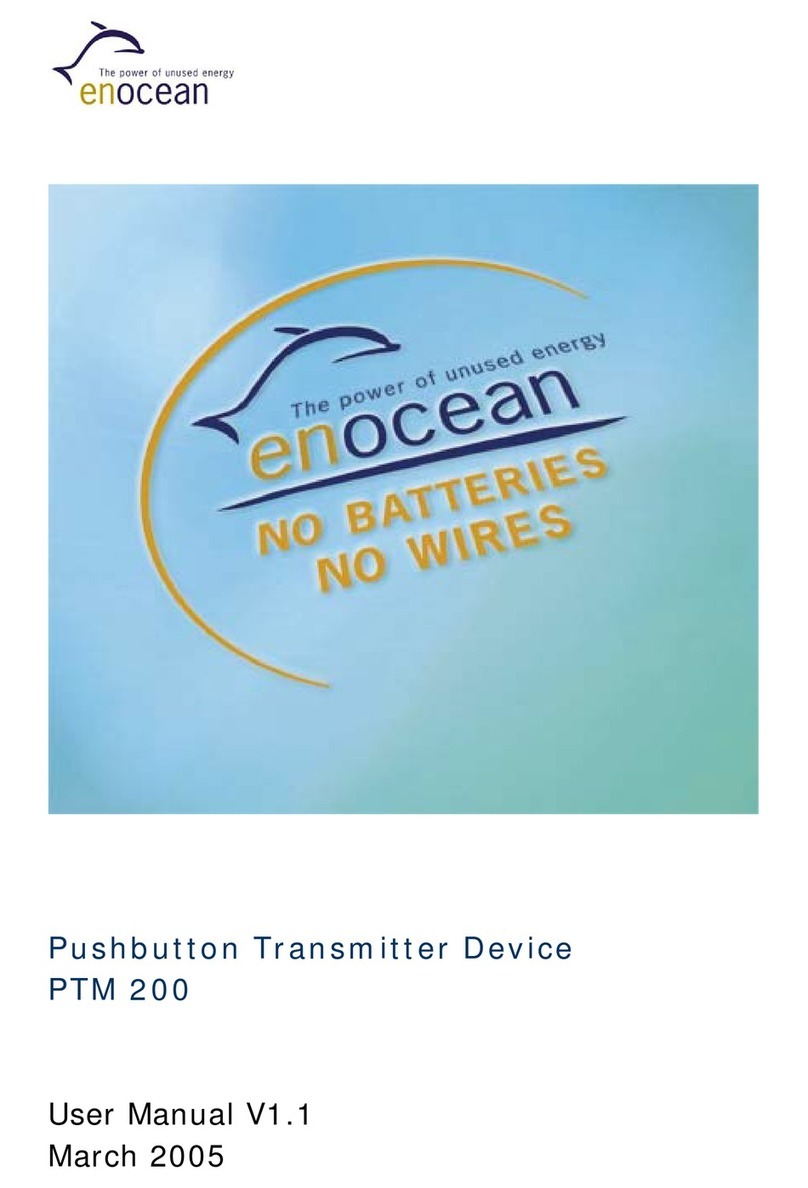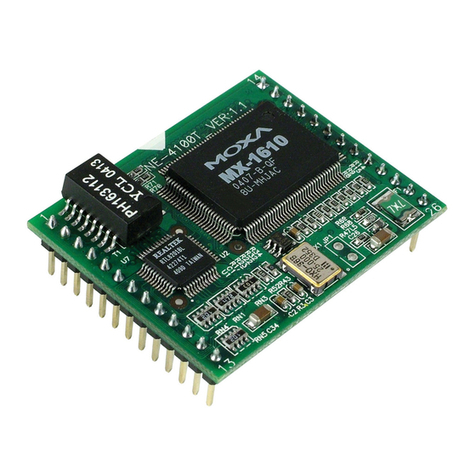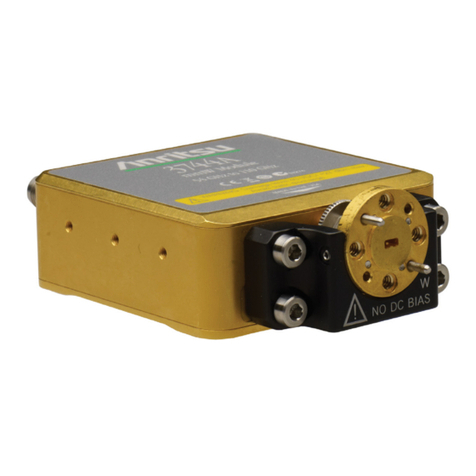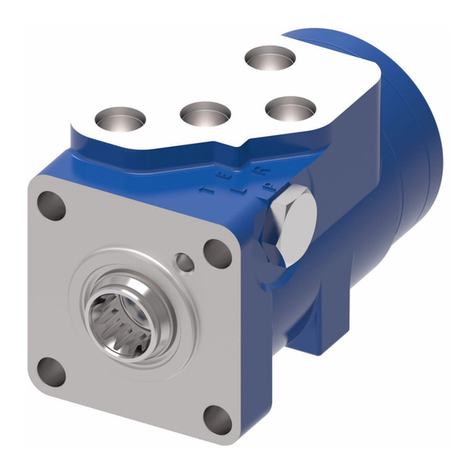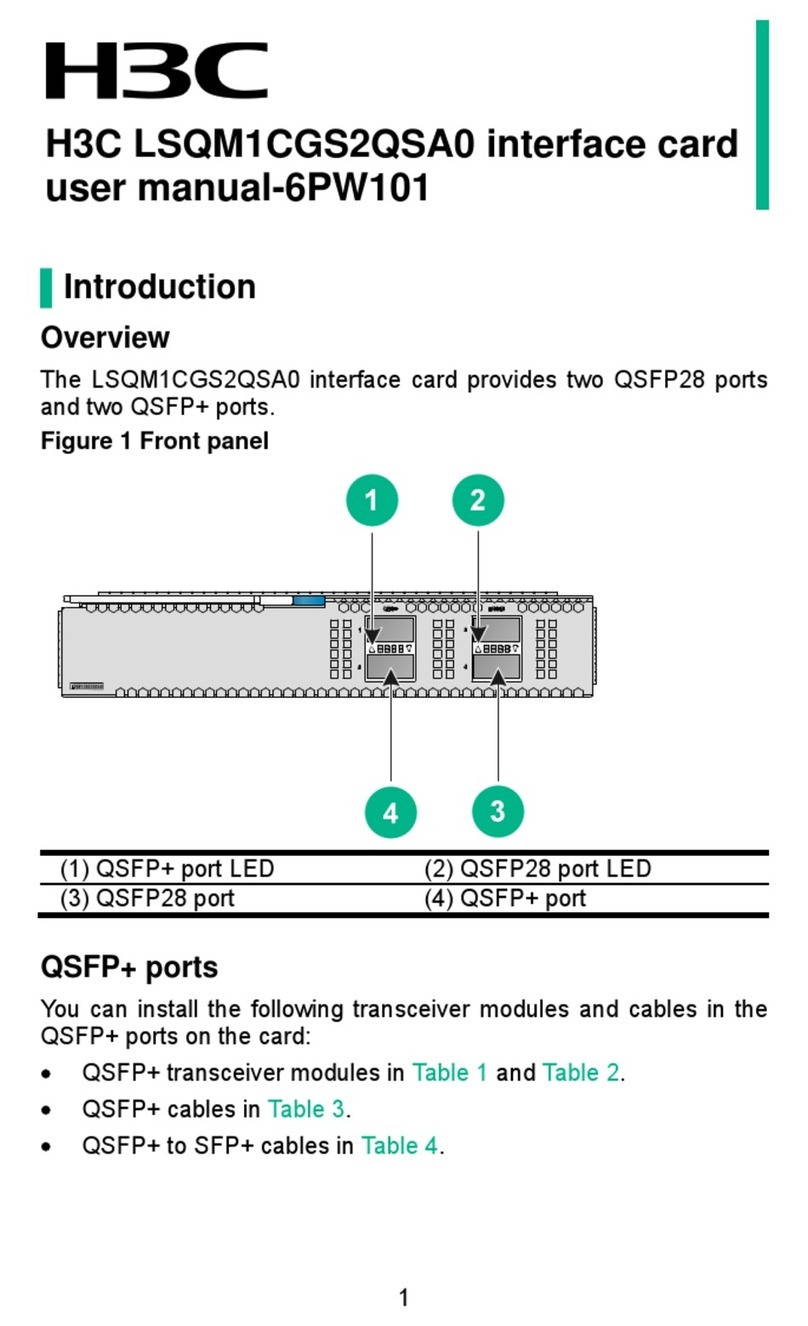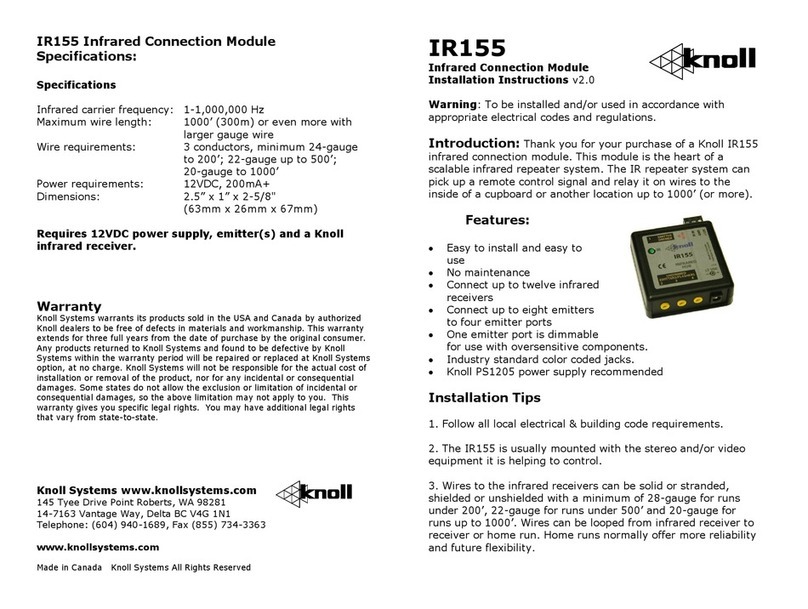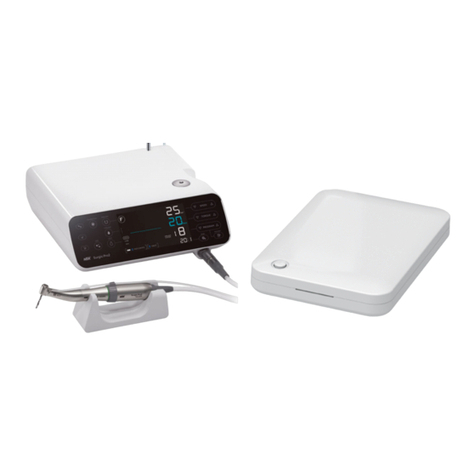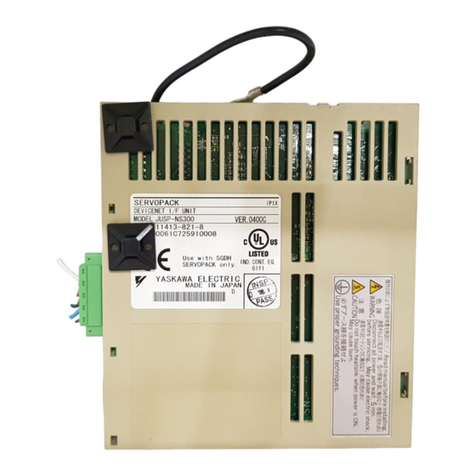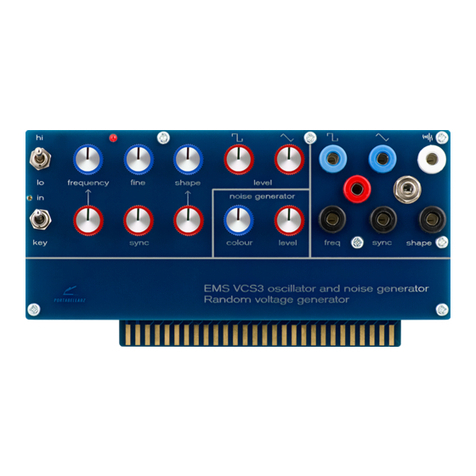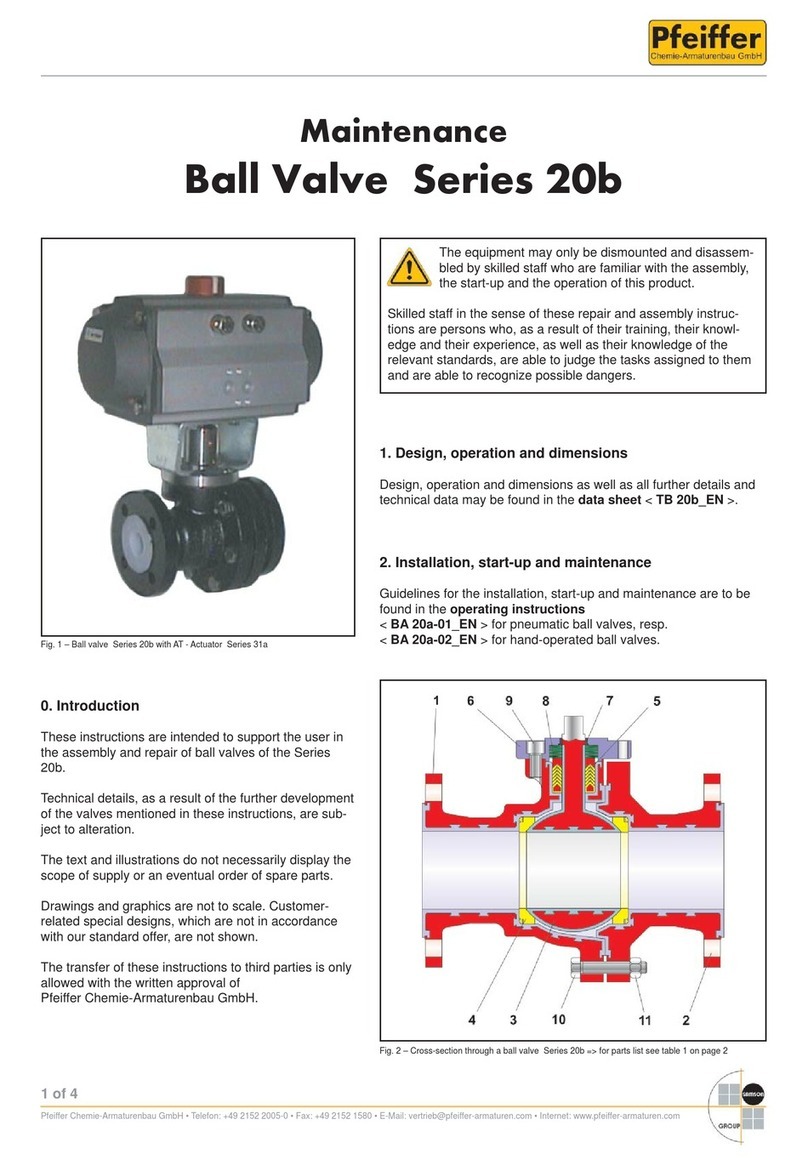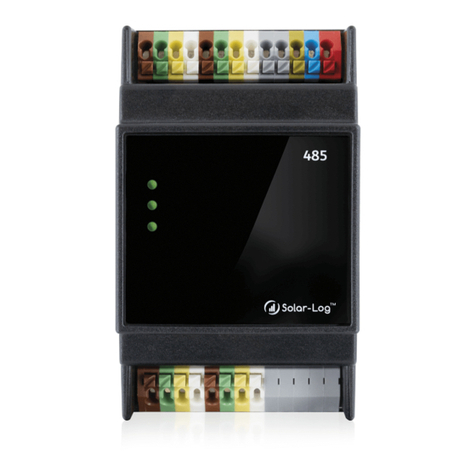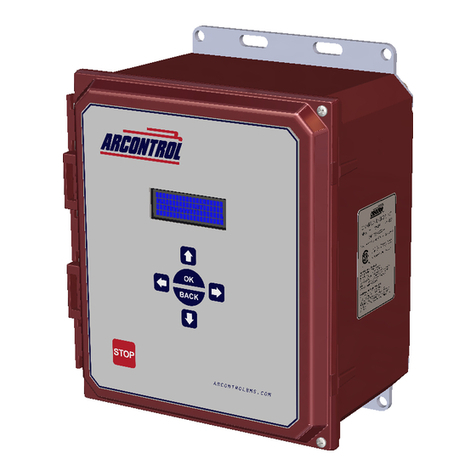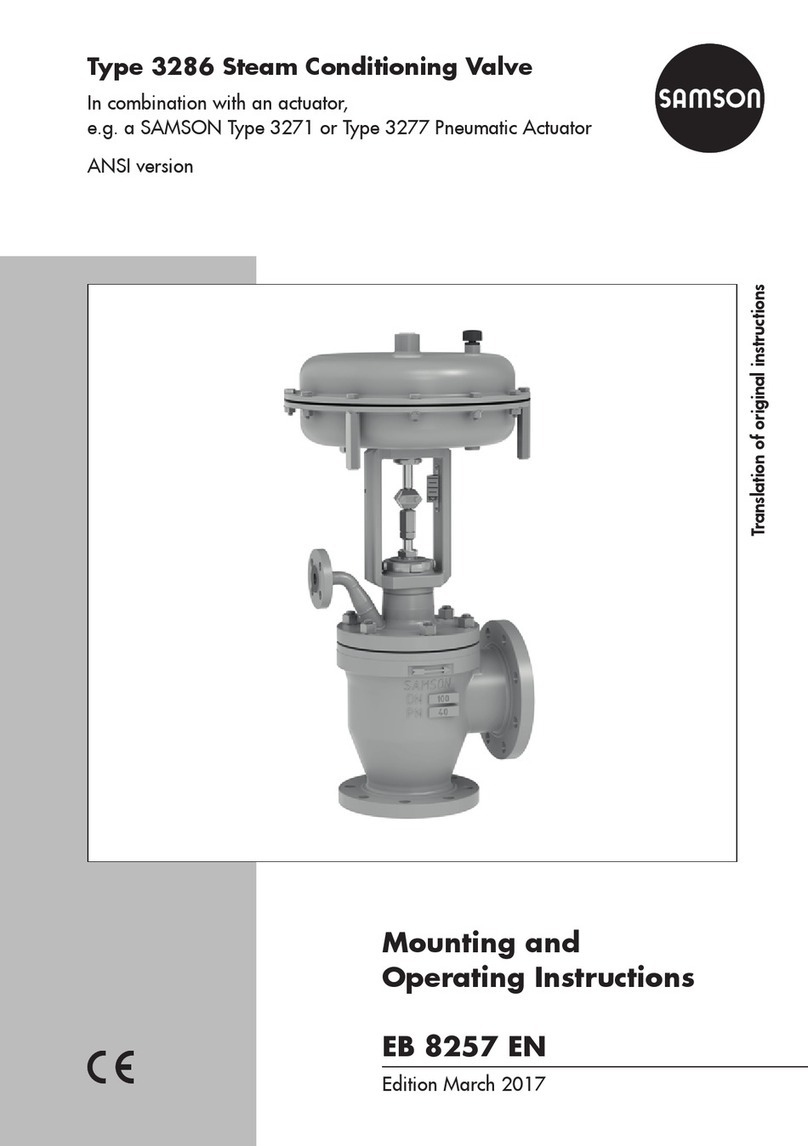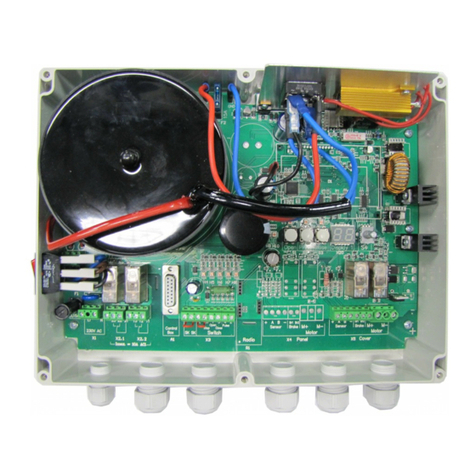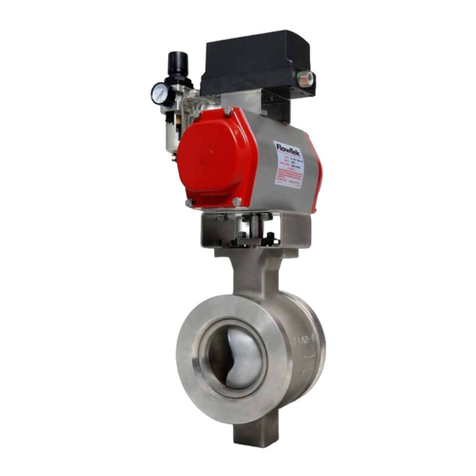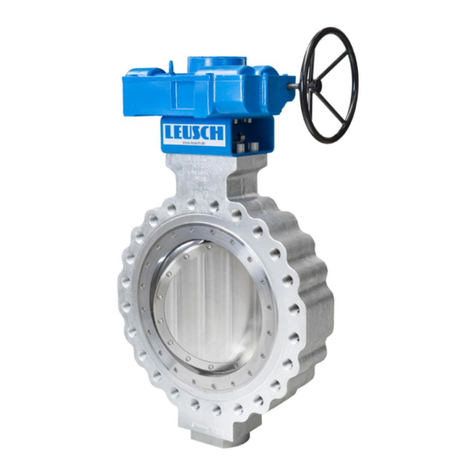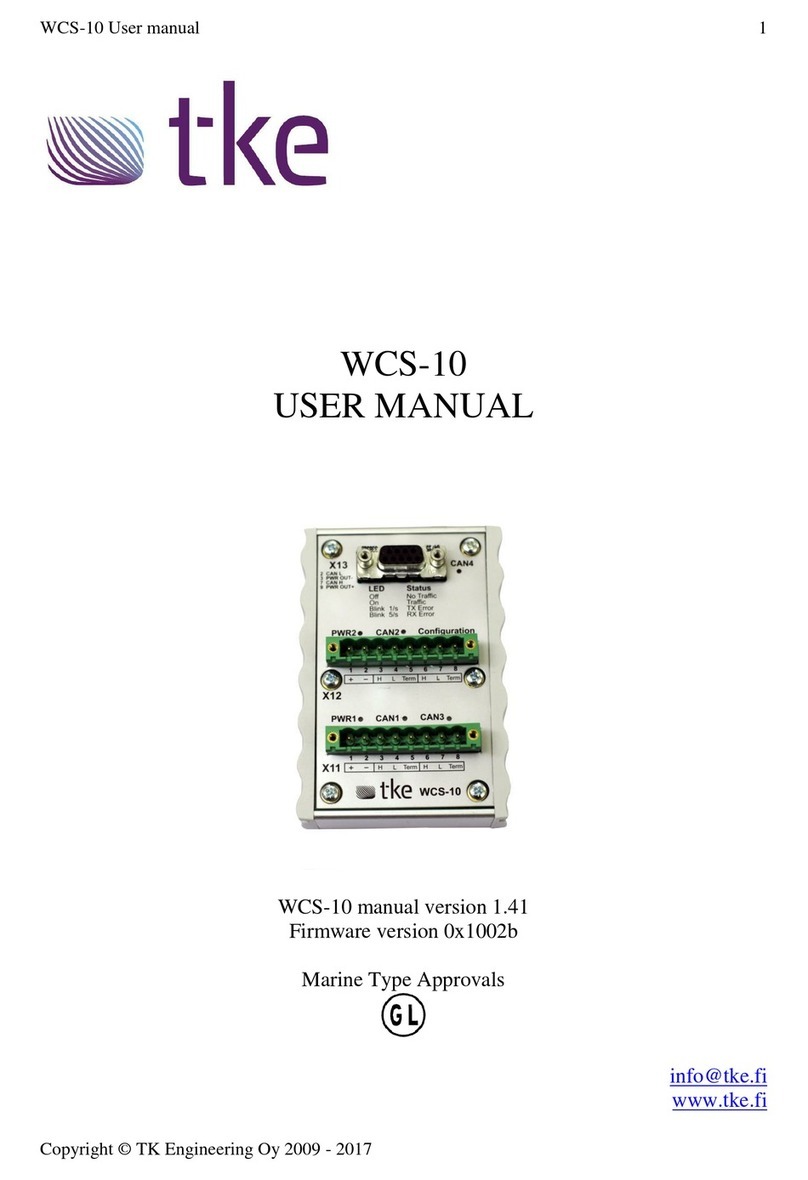EnOcean TCM 300 User manual

USER MANUAL V1.25
EnOcean GmbH
Kolpingring 18a
82041 Oberhaching
Germany
Phone +49.89.67 34 689-0
Fax +49.89.67 34 689-50
info@enocean.com
www.enocean.com
Subject to modifications
TCM 300 / 300C / 320 / 320C User Manual V1.25
June 14, 2011 4:53 PM
Page 1/52
Patent protected:
WO98/36395, DE 100 25 561, DE 101 50 128,
WO 2004/051591, DE 103 01 678 A1, DE 10309334,
WO 04/109236, WO 05/096482, WO 02/095707,
US 6,747,573, US 7,019,241
Observe precautions! Electrostatic sensitive devices!
Transceiver Module
TCM 300 / TCM 300C
TCM 320 / TCM 320C
June 14, 2011
Downloaded from Elcodis.com electronic components distributor

USER MANUAL V1.25
© 2010 EnOcean | www.enocean.com TCM 300 / 300C / 320 / 320C User Manual V1.25 | Page 2/52
TCM 300 / 300C / 320
/
320C
REVISION HISTORY
The following major modifications and improvements have been made to the first version of
this document:
No Major Changes
1.01 Tape running direction added in 3.8
1.02 Dimension of TCM 320 corrected (width 18 mm instead of 19 mm)
1.03 Editorial changes
1.10 Timing information regarding serial protocol added in A.2, A.3. 0xFFFF_FFFF ex-
cluded from usable ID range, because this ID will be used as broadcast ID.
1.20 Error corrected in 3.2.1. and 4.1: Maximum gain of external antenna at 50Ohm
output RF_50 is 0dBi! Error corrected in 2.2: WXODIO is confi
g
ured as output and
provides information on VON signal
1.21 Note added in 3.5
1.25 Remarks added regarding use of IOVDD in 2.2.; Antenna specification in 3.3.1 ex-
tended. Updated information on conducted output power in 1.2; A.2.2 chan
g
ed to
point to EnOcean Alliance Website; A.2.3 and A.2.4 removed; editorial changes
Published by EnOcean GmbH, Kolpingring 18a, 82041 Oberhaching, Germany
www.enocean.com, info@enocean.com, phone +49 (89) 6734 6890
© EnOcean GmbH
All Rights Reserved
Important!
This information describes the type of component and shall not be considered as assured characteris-
tics. No responsibility is assumed for possible omissions or inaccuracies. Circuitry and specifications
are subject to change without notice. For the latest product specifications, refer to the EnOcean web-
site: http://www.enocean.com.
As far as patents or other rights of third parties are concerned, liability is only assumed for modules,
not for the described applications, processes and circuits.
EnOcean does not assume responsibility for use of modules described and limits its liability to the
replacement of modules determined to be defective due to workmanship. Devices or systems contain-
ing RF components must meet the essential requirements of the local legal authorities.
The modules must not be used in any relation with equipment that supports, directly or indirectly,
human health or life or with applications that can result in danger for people, animals or real value.
Components of the modules are considered and should be disposed of as hazardous waste. Local
government regulations are to be observed.
Packing: Please use the recycling operators known to you.
Downloaded from Elcodis.com electronic components distributor

USER MANUAL V1.25
© 2010 EnOcean | www.enocean.com TCM 300 / 300C / 320 / 320C User Manual V1.25 | Page 3/52
TCM 300 / 300C / 320
/
320C
TABLE OF CONTENT
1GENERAL DESCRIPTION .................................................................................5
1.1 Basic functionality..........................................................................................5
1.2 Technical data...............................................................................................5
1.3 Physical dimensions .......................................................................................6
1.4 Environmental conditions................................................................................7
1.5 Ordering information......................................................................................7
2FUNCTIONAL DESCRIPTION ............................................................................8
2.1 Pin out .........................................................................................................8
2.2 Pin description and operational characteristics...................................................9
2.2.1 GPIO supply voltage - IOVDD ....................................................................11
2.3 Absolute maximum ratings (non operating) ....................................................12
2.4 Maximum ratings (operating) ........................................................................12
2.5 Operating modes .........................................................................................13
2.6 Mode selection ............................................................................................14
2.7 Repeater configuration .................................................................................15
2.8 Teach-in procedure ......................................................................................16
2.8.1 Setting the receiver to learning mode.........................................................16
2.8.2 Confirmation of Learning Mode ..................................................................16
2.8.3 Teaching in a transmitter..........................................................................16
2.8.4 Confirmation of correct learning/deletion ....................................................17
2.8.5 Learning of further transmitters.................................................................17
2.8.6 Selecting the next channel........................................................................17
2.8.7 Leaving learning mode .............................................................................17
2.8.8 Deleting a transmitter ..............................................................................17
2.9 Remote management ...................................................................................18
2.9.1 Remote Management Control Commands (RMCC) ........................................18
2.9.2 Remote Procedure Calls (RPC)...................................................................18
2.10 Smart Acknowledge ................................................................................19
2.11 Transmit timing ......................................................................................19
3APPLICATIONS INFORMATION.......................................................................20
3.1 Transmission range......................................................................................20
3.2 Antenna options TCM 300 / TCM 300C............................................................21
3.2.1 Overview ................................................................................................21
3.2.2 Whip antenna..........................................................................................22
3.2.3 Chip antenna...........................................................................................23
3.2.4 Splatch antenna ......................................................................................25
3.2.5 Helical antenna........................................................................................26
3.3 Antenna options TCM 320 / 320C...................................................................27
3.3.1 Mounting the whip antenna.......................................................................27
3.3.2 Mounting 50 Ωantennas...........................................................................28
3.4 Recommendations for laying a whip antenna...................................................29
3.5 Power supply requirements ...........................................................................30
3.6 Layout recommendations..............................................................................30
3.6.1 TCM 300/300C recommended foot pattern ..................................................31
3.7 Soldering information...................................................................................34
3.7.1 TCM 300 / TCM 300C ...............................................................................34
3.7.2 TCM 320 / TCM 320C ...............................................................................35
3.8 Tape & Reel specification TCM 300 / TCM 300C ...............................................35
Downloaded from Elcodis.com electronic components distributor

USER MANUAL V1.25
© 2010 EnOcean | www.enocean.com TCM 300 / 300C / 320 / 320C User Manual V1.25 | Page 4/52
TCM 300 / 300C / 320
/
320C
3.9 Backward compatibility to TCM 220C..............................................................36
3.10 Using RVDD ...........................................................................................36
3.11 Voltage dips ...........................................................................................36
4AGENCY CERTIFICATIONS ............................................................................37
4.1 CE approval ................................................................................................37
4.2 FCC (United States) Certification ...................................................................38
4.3 IC (Industry Canada) Certification .................................................................41
ASerial Interface ...........................................................................................43
A.1 EnOcean serial protocol ................................................................................43
A.1.1 Message format (ESP2) ............................................................................43
A.1.2 Byte signals and bit order .........................................................................43
A.1.3 Description of serial data structure.............................................................44
A.2 Radio transmission/reception commands ........................................................45
A.2.1 Detailed description of ORG, DATA_BYTE, and STATUS fields ........................45
A.3 Command telegrams and messages ...............................................................46
A.3.1 ID Range commands ................................................................................46
A.3.2 Receiver sensitivity commands ..................................................................46
A.3.3 Reset command.......................................................................................46
A.3.4 SW Version .............................................................................................46
A.3.5 Error messages .......................................................................................47
A.3.6 Command Encoding .................................................................................48
Downloaded from Elcodis.com electronic components distributor

USER MANUAL V1.25
© 2010 EnOcean | www.enocean.com TCM 300 / 300C / 320 / 320C User Manual V1.25 | Page 5/52
TCM 300 / 300C / 320
/
320C
1GENERAL DESCRIPTION
1.1 Basic functionality
The transceiver modules TCM 300 / 300C and TCM 320 / 320C
enable the realization of highly efficient RF repeaters and
transceivers for the EnOcean 868 MHz and 315 MHz radio sys-
tems. The module provides several built-in operating modes.
In addition repeater functionality (1 or 2 level) can be acti-
vated. Using the Dolphin API library it is possible to write cus-
tom software for the module. All module variants are in-system
programmable.
Built-in operating modes
Unidirectional serial communication
Bidirectional serial communication
1-channel relay mode
4-channel relay mode
1-channel dimming mode
Product variants
TCM 300/300C: SMD mountable module for use with external antenna (868/315 MHz)
TCM 320/320C: Variant for vertical mounting with pin connector. Whip antenna.
(868/315 MHz). TCM 320C is backward compatible to TCM 220C
Features accessible via API:
Integrated 16 MHz 8051 CPU with 32 KB FLASH and 2 kB SRAM
Various power down and sleep modes
TCM 300/300C down to 0.2 µA current consumption
TCM 320/320C down to 1.4 mA current consumption
Up to 14 configurable I/Os (TCM 300/300C)
10 bit ADC, 8 bit DAC
1.2 Technical data
A
ntenna Pre-installed 8.6 cm/15 cm whip antenna (TCM 320/TCM 320C)
External whip or 50 Ωantenna mountable (TCM 300/TCM 300C)
Fre
q
uenc
y
315.0 MHz (TCM 3X0C)/868.3 MHz (TCM 3X0)
Radio Standard EnOcean 868 MHz/315 MHz
Data rate/Modulation t
yp
e 125 kbps/ASK
Receiver Sensitivit
y
(
at 25°C
)
typ. –96 dBm1(868 MHz)
typ. -98 dBm1(315 MHz)
Conducted Out
p
ut Power @50Ω
min / t
yp
/max
TCM 300: 3.0 dBm / 5.7 dBm / 7.0 dBm
TCM 300C: 5.5 dBm / 7.5 dBm / 9.5 dBm
TCM 320: 1.2 dBm / 3.1 dBm / 5.2 dBm
TCM 320C: 3.5 dBm / 5.5 dBm / 7.5 dBm
Power Su
pp
l
y
2.6 V–3.3 V (TCM 320/320C), 2.6 V–4.5 V (TCM 300/300C)
Current Consum
p
tion Receive mode: typ. 33 mA, max. 43 mA (RX)
Transmit mode: typ. 24 mA, max. 33 mA (TX)
1@ 0.1% telegram error rate (based on 3 transmitted sub-telegrams)
Downloaded from Elcodis.com electronic components distributor

USER MANUAL V1.25
© 2010 EnOcean | www.enocean.com TCM 300 / 300C / 320 / 320C User Manual V1.25 | Page 6/52
TCM 300 / 300C / 320
/
320C
Radio Re
g
ulations R&TTE EN 300 220 (TCM 300/TCM 320)
FCC CFR-47 Part 15 (TCM 300C/TCM 320C)
1.3 Physical dimensions
TCM 300 / TCM 300C (pads on bottom side of PCB!)
TCM 320 / TCM 320C
Unless otherwise specified dimensions are in mm.
Tolerances:
PCB outline dimensions ±0.2 mm
All other tolerances ±0.1 mm
Unless otherwise specified dimensions are in mm.
Tolerances:
PCB outline dimensions ±0.2 mm
All other tolerances ±0.1 mm
Downloaded from Elcodis.com electronic components distributor

USER MANUAL V1.25
© 2010 EnOcean | www.enocean.com TCM 300 / 300C / 320 / 320C User Manual V1.25 | Page 7/52
TCM 300 / 300C / 320
/
320C
PCB dimensions TCM 320/TCM 320C (without pin connector): 36.5 x 18 x 5.5 mm
TCM 300/TCM 300C: 22 x 19 x 3.1 mm
Pin connector 16 pins, grid 2.0 mm (4.0 mm in length, 0.5 mm)
Weight TCM 320/320C: 3.7 g TCM 300/300C: 1.9 g
1.4 Environmental conditions
Operating temperature -25 °C … +85 °C
Storage temperature -40 °C … +85 °C
Storage temperature in tape & reel package -20 °C … +50 °C
Humidity 0% … 93% r.H., non-condensing
1.5 Ordering information
Type Ordering Code Frequency
TCM 300 S3003-K300 868.3 MHz
TCM 320 S3003-K320 868.3 MHz
TCM 300C S3033-K300 315.0 MHz
TCM 320C S3033-K320 315.0 MHz
Downloaded from Elcodis.com electronic components distributor

USER MANUAL V1.25
© 2010 EnOcean | www.enocean.com TCM 300 / 300C / 320 / 320C User Manual V1.25 | Page 8/52
TCM 300 / 300C / 320
/
320C
2FUNCTIONAL DESCRIPTION
2.1 Pin out
The figure above shows the pin out of the TCM 300 / TCM 320 hardware. The pins are
named according to the naming of the EO3000I chip to simplify usage of the DOLPHIN API.
The table in section 2.2 shows the translation of hardware pins to a naming that fits the
functionality of the built-in firmware. When writing own firmware based on the DOLPHIN
API please refer to the Dolphin Core Description and use this manual only for information
regarding the module hardware, such as pin out, layout recommendations, power supply
requirements, antenna options, and approvals.
ADIO0
ADIO1
ADIO2
ADIO3
ADIO4
ADIO6
ADIO7
GND
SCSEDIO0
SCLKDIO1
WSDADIO2
RSDADIO3
PROG_EN
RESET
VDD
GND
RF_WHIP
EO3000I
Antenna
balun
XTAL
16MHz
116
TCM320/320C
TOP VIEW
EO3000I
Antenna
balun
XTAL
16MHz
TCM300/300C
TOP VIEW
DVDD
RVDD
n.c.
IOVDD
SCSEDIO0
WXIDIO
WXODIO
n.c.
RESET
n.c.
ADIO0
ADIO1
ADIO2
ADIO3
ADIO4
ADIO5
ADIO6
ADIO7
PROG_EN
SCLKDIO1
WSDADIO2
RSDADIO3
GND
GND
GND
RF_50
RF_WHIP
n.c.
VDD
GND
GND
GND
GND
GND
1
918
26
Downloaded from Elcodis.com electronic components distributor

USER MANUAL V1.25
© 2010 EnOcean | www.enocean.com TCM 300 / 300C / 320 / 320C User Manual V1.25 | Page 9/52
TCM 300 / 300C / 320
/
320C
2.2 Pin description and operational characteristics
HW Symbol Function Characteristics
GND Ground connection Must be connected to GND; see 3.5
VDD Supply voltage TCM 300/300C: 2.6 V – 4.5 V
TCM 320/320C: 2.6 V – 3.3 V
Max. ripple: see 2.4
RVDD
RF supply voltage
regulator output
1.8 V
Output current:
max. 100 µA with built-in firmware (RX on)
max. 10 mA while not in RX/TX mode
DVDD
Digital supply voltage
regulator output
1.8 V
Output current: max. 5 mA
IOVDD
GPIO supply voltage TCM 320/320C: internally connected to VDD
TCM 300/300C: Must be connected to desired
interface supply voltage (see 2.4)
See also 2.2.1.
RESET Reset input
Programming I/F
Active high reset (1.8 V). External 10 kΩpull-
down required.
PROG_EN
Programming I/F HIGH: programming mode active
LOW: operating mode
Digital input, external 10 kΩpull-down re-
quired.
ADIO0
MODE_SEL Analog input: At start-up input voltage is
measured and mode is selected. See chapter
2.6.
ADIO1 MODE 0: not used
In mode 0 the repeater level is 1 and
cannot be modified.
MODE 1-4: REP_LEVEL Mode 1-4: At start-up the repeater level
is selected:
Repeater level 1: LOW
Repeater level 2: HIGH
Digital input, internal pull-up active
ADIO2 REPEATER At start-up the repeater can be switched on:
Repeater on: LOW
Repeater off: HIGH
Digital input, internal pull-up active
ADIO3 MODE 0: Sensitivity Low sensitivity: LOW
High sensitivity: HIGH
Digital input, internal pull-up active
MODE 1-4: LRN Enter/leave teach-in mode. See chapter 2.8
Digital input, internal pull-up active
ADIO4
MODE 0: not used Internal pull-up active
MODE 1-4: CLR Clear ID memory. See chapter 2.8
Digital input, internal pull-up active
ADIO5 Not used Digital output, internally set to LOW
ADIO6 MODE 0-1: SER_RX UART input
MODE 2-4: not used Digital input, internal pull-up active
Downloaded from Elcodis.com electronic components distributor

USER MANUAL V1.25
© 2010 EnOcean | www.enocean.com TCM 300 / 300C / 320 / 320C User Manual V1.25 | Page 10/52
TCM 300 / 300C / 320
/
320C
ADIO7 MODE 0-1: SER_TX UART output
Max. output current:
2 mA @ IOVDD=3.3 V
0.65 mA @ IOVDD=1.8 V
MODE 2-3: CHANNEL0 Digital output channel 0
Max. output current:
2 mA @ IOVDD=3.3 V
0.65 mA @ IOVDD=1.8 V
MODE 4: not used Digital output, internally set to LOW
Programming I/F
SCSEDIO0
MODE 0, 2: not used Digital output, internally set to LOW
MODE 1: LRN_TOGGLE Digital output
Max. output current:
2 mA @ IOVDD=3.3 V
0.65 mA @ IOVDD=1.8 V
MODE 3: CHANNEL1 Digital output channel 1
Max. output current:
2 mA @ IOVDD=3.3 V
0.65 mA @ IOVDD=1.8 V
MODE 4: PWM Dimmer output, 50 kHz
Programming I/F
SCLKDIO1 MODE 0-2: not used Digital output, internally set to LOW
MODE 3: CHANNEL2 Digital output channel 2
Max. output current:
2 mA @ IOVDD=3.3 V
0.65 mA @ IOVDD=1.8 V
MODE 4: PWM_IND Indicating if PWM is active.
Digital output.
Max. output current:
2 mA @ IOVDD=3.3 V
0.65 mA @ IOVDD=1.8 V
Programming I/F
WSDADIO2 MODE 0-2, 4: not used Digital output, internally set to LOW
MODE 3: CHANNEL3 Digital output channel 3
Max. output current:
2 mA @ IOVDD=3.3 V
0.65 mA @ IOVDD=1.8 V
Programming I/F
RSDADIO3 MODE 0: RMI Normal operation: Di
g
ital output, internally set
to LOW
Remote Management: ACTION command indi-
cator (see 2.9.1)
Max. output current:
2 mA @ IOVDD=3.3 V
0.65 mA @ IOVDD=1.8 V
MODE 1-4: LMI Normal operation: Learn mode indicator
Remote Management: ACTION command indi-
cator (see 2.9.1)
Digital output
Downloaded from Elcodis.com electronic components distributor

USER MANUAL V1.25
© 2010 EnOcean | www.enocean.com TCM 300 / 300C / 320 / 320C User Manual V1.25 | Page 11/52
TCM 300 / 300C / 320
/
320C
Max. output current:
2 mA @ IOVDD=3.3 V
0.65 mA @ IOVDD=1.8 V
Programming I/F
WXIDIO Not used Digital output, internally set to LOW
WXODIO Not used Digital output, HIGH if VDD>VON, LOW if
VDD<VON, see also 3.11
RF_WHIP RF output Output for whip antenna
RF_50 RF output 50 Ohm output for external antenna
n.c. Not connected Do not connect!
2.2.1 GPIO supply voltage - IOVDD
For digital communication with other circuitry (peripherals) the digital I/O configured pins
of the mixed signal sensor interface (ADIO0 to ADIO7) and the pins of the serial interface
(SCSEDIO0, SCLKDIO1, WSDADIO2, RSDADIO3) may be operated from supply voltages
different from DVDD. Therefore an interface voltage supply pin IOVDD is available which
can be connected either to DVDD or to an external supply within the tolerated voltage
range of IOVDD.
If DVDD=0 V (e.g. in any sleepmode) and IOVDD is supplied, there may be un-
predictable and varyin
g
current from IOVDD caused by internal floatin
g
nodes. It
must be taken care that the current into IOVDD does not exceed 10 mA while
DVDD=0 V.
If DVDD=0 V and IOVDD is not supplied, do not apply voltage to any above men-
tioned pin. This may lead to unpredictable malfunction of the device.
In TCM 320/TCM 320C VDD is internally connected to IOVDD! Therefore the above
mentioned issues have to be considered when writing own firmware based on API.
IOVDD voltage must not exceed VDD voltage! A malfunction of the module may be
caused by such inverse supply!
For I/O pins configured as analog pins the IOVDD voltage level is not relevant!
However it is important to connect IOVDD to a supply voltage as specified in 2.4.
Downloaded from Elcodis.com electronic components distributor

USER MANUAL V1.25
© 2010 EnOcean | www.enocean.com TCM 300 / 300C / 320 / 320C User Manual V1.25 | Page 12/52
TCM 300 / 300C / 320
/
320C
2.3 Absolute maximum ratings (non operating)
Symbol Parameter Min Max Units
VDD
Supply voltage at VDD
TCM 300
TCM 320 (limitation due to internal VDD-IOVDD connection)
-0.5
-0.5
5.5
3.6
V
V
IOVDD GPIO supply voltage -0.5 3.6 V
GND Ground connection 0 0 V
VINA Voltage at every analog input pin -0.5 2 V
VIND1 Voltage at RESET, and every digital input pin except WXI-
DIO/WXODIO
-0.5 3.6 V
VIND2 Voltage at WXIDIO / WXODIO input pin -0.5 2 V
2.4 Maximum ratings (operating)
Symbol Parameter Min Max Units
VDD
Supply voltage at VDD
TCM 300
TCM 320
2.6
2.6
4.5
3.3
V
V
IOVDD GPIO supply voltage (see also 2.2.1)
1.7 MIN
(3.6;
VDD)
V
GND Ground connection 0 0 V
VINA Voltage at every analog input pin 0 2.0 V
VIND1 Voltage at RESET, and every digital input pin except
WXIDIO / WXODIO
0 3.6 V
VIND2 Voltage at WXIDIO / WXODIO input pin 0 2.0 V
VDDR Max. ripple at VDD 50 mVpp
Downloaded from Elcodis.com electronic components distributor

USER MANUAL V1.25
© 2010 EnOcean | www.enocean.com TCM 300 / 300C / 320 / 320C User Manual V1.25 | Page 13/52
TCM 300 / 300C / 320
/
320C
2.5 Operating modes
Mode Function Output signal description No. of
channels
0
Unidirectional serial
interface compatible
with TCM 220C, no
teach-in capability
SER_TX: UART output, supplies standard
data blocks of information from all received
EnOcean radio telegrams (9600 bps; 8 data
bits, no parity bit, one start bit, one stop bit).
For further information see chapter A.1
1
Bidirectional serial
interface, teach-in
capability for up to
30 entries2
SER_RX, SER_TX: Asynchronous bidirectional
Interface, supplies standard data blocks of
information from all received EnOcean radio
telegrams (9600 bps; 8 data bits, no parity
bit, one start bit, one stop bit). For further
information see chapter A.1
LRN_TOGGLE: Learning mode status indica-
tor
2 Rocker Switch - 1
channel, teach-in ca-
pability for up to 30
entries2
Supplies the desired logic switching state
“on/off” at CHANNEL0 when pushing the
switch rockers
1
3 Rocker Switch - 4
channels, teach-in
capability for up to
30 entries3
Same as Mode 2 but operation of 4 receiver
channels (CHANNEL0, CHANNEL1, CHAN-
NEL2, CHANNEL3)
4
4 Dimming - 1 channel,
teach-in capability
for up to 30 entries2
PWM is the PWM output
I-button pressed for shorter than 0.5 s: ON
(Restore duty cycle stored before last
switch-off).
O-button pressed for shorter than 0.5 s:
OFF
O-/I-button pressed longer than 0.5 s:
Duty cycle variation from 10% up to 100%
(O=less, I=more; ~300 PWM steps, in-
crement every 15 ms). Duty cycle variation
stops when button is released.
PWM_IND is active as long as duty cycle is
not 0%
1
5 Reserved
2Each rocker of a PTM transmitter is counted as 1 entry
3Each rocker is counted as 1 entry. If the same rocker is teached into several channels, 1
entry per channel is needed.
Downloaded from Elcodis.com electronic components distributor

USER MANUAL V1.25
© 2010 EnOcean | www.enocean.com TCM 300 / 300C / 320 / 320C User Manual V1.25 | Page 14/52
TCM 300 / 300C / 320
/
320C
2.6 Mode selection
The operating mode is defined at start-up of the module via a measurement of the voltage
at ADIO0.
Mode ADIO0 (MODE_SEL)
input voltage range
Proposed com-
ponent values
0 0% to 3.99% VDD R1: 0 Ohm
R2: leave open
R3: leave open
C1: leave open
1 4% to 11.99% VDD R1: 1k2 ±1%
R2: 15k ±1%
R3: 150k ±1%
C1: 100p
2 12% to 19.99% VDD R1: 2k2 ±1%
R2: 12k ±1%
R3: 270k ±1%
C1: 100p
3 20% to 27.99% VDD R1: 3k9 ±1%
R2: 15k ±1%
R3: 68k ±1%
C1: 100p
4 28% to 35.99% VDD R1: 4k7 ±1%
R2: 12k ±1%
R3: 56k ±1%
C1: 100p
5 36% to 39.99% VDD R1: 5k6 ±1%
R2: 10k ±1%
R3: 56k ±1%
C1: 100p
As long as IDs are stored in ID memory, the operating mode can only be changed
after deleting all IDs from memory, e.g. via CLR!
R2
R1
VDD
GND
ADIO0
R3
C1
Downloaded from Elcodis.com electronic components distributor

USER MANUAL V1.25
© 2010 EnOcean | www.enocean.com TCM 300 / 300C / 320 / 320C User Manual V1.25 | Page 15/52
TCM 300 / 300C / 320
/
320C
2.7 Repeater configuration
TCM 3x0 provides the option to activate a one or two-level repeater for EnOcean radio tele-
grams.
1-level repeater: If a received telegram is a valid and original (not yet repeated), the tele-
gram is repeated after a random delay.
2-level repeater: If a received telegram is valid and original or repeated once, the telegram
is repeated after a random delay.
The repeated telegram is marked as “repeated” by an increased repeater counter.
Setting the repeater level:
At start-up of the module repeater on/off and repeater level are determined.
Please refer to the table in 2.2 regarding the configuration options.
The figure below shows an example circuit for a repeater.
2-level repeating function should only be activated if really needed! Otherwise the
system function can be compromised by collisions of telegrams.
Please note that in Mode 0 2-level repeating is not possible
(for backward compatibility to TCM 220C)!
Downloaded from Elcodis.com electronic components distributor

USER MANUAL V1.25
© 2010 EnOcean | www.enocean.com TCM 300 / 300C / 320 / 320C User Manual V1.25 | Page 16/52
TCM 300 / 300C / 320
/
320C
2.8 Teach-in procedure
Modes 1 to 4 support teach-in of transmitters.
2.8.1 Setting the receiver to learning mode
Via CLR Pin (ADIO4): Contact to GND longer than t = 2 seconds. Learning Mode LRN
is entered after clearing ID memory.
Via LRN Pin (ADIO3): Contact to GND longer than t = 0.5 seconds. In multi-channel
receiver mode, the pin has to be contacted several times until the desired channel num-
ber is selected (the number of channels is given by the selected operating mode).
Via Remote Config Control: Please refer to documentation of remote management.
2.8.2 Confirmation of Learning Mode
Mode Confirmation
0 No Learn capability
1 LMI HIGH continuously, LRN_TOGGLE toggling every 1 s.
2 LMI HIGH continuously, CHANNEL0 toggling every 1 s.
3 LMI HIGH continuously, current CHANNELx toggling every 1 s.
4 LMI HIGH continuously, DIM IND HIGH, and PWM toggling every 1 s between
10% and 100%
5 Reserved for future use
2.8.3 Teaching in a transmitter
In learning mode LRN, the sensitivity of the module is limited to in-room operations and
learning of repeater powered signals is disabled (to avoid unintentional learning). Therefore
ensure that the associated radio transmitter will be in a distance less than 5 m to the re-
ceiver (not necessary within Remote Learn Mode).
Trigger the telegram of the associated radio transmitter within 30 seconds:
Operate the switch radio transmitter (RPS or HRC) at least once (press I-button or O-
button of the rocker that is to be assigned to the selected receiver channel). If the same
rocker is operated again within 4 seconds it will still be learned. If the same rocker is op-
erated again after more than 4 seconds it will be deleted again. Please note that teach-in
without rocker information is not possible” Please note that scene switches (HRC and last
3 ID bits 0B111) cannot be teach-in!
Or activate the sensor radio transmitter (1BS, 4BS) least once with active LRN bit
(DI_3=0, please refer to “Standardization EnOcean Communication Profiles”). If the
same transmitter is operated again after more than 4 seconds with active LRN bit it will
be deleted again.
Please make sure not to remove supply voltage while in LRN mode! The flash con-
tent could get corrupted!
Downloaded from Elcodis.com electronic components distributor

USER MANUAL V1.25
© 2010 EnOcean | www.enocean.com TCM 300 / 300C / 320 / 320C User Manual V1.25 | Page 17/52
TCM 300 / 300C / 320
/
320C
2.8.4 Confirmation of correct learning/deletion
The output which is toggling every second while in teach-in mode (see above) will stay
switched high for 4 seconds to signal that a transmitter has been learned. In case a trans-
mitter ID has been deleted it will stay 4 seconds low.
2.8.5 Learning of further transmitters
After confirmation, the receiver changes again to readiness for learning. Further transmit-
ters can be learned immediately. If available the next receiver channel can be entered by
connecting the LRN pin to GND longer than t = 0.5 seconds. A maximum of 30 radio
transmitters can be learned (further attempts will be ignored; instead of learning confirma-
tion, operating mode is entered). Each rocker of a radio transmitter is counted as one
transmitter.
2.8.6 Selecting the next channel
By fresh contacting of the LRN pin to GND the next remaining channel is selected. In one-
channel mode or after the last channel, the operating mode is entered again.
2.8.7 Leaving learning mode
LRN mode is left in either one of the following events:
Output of last available channel is toggling and a fresh contacting of the LRN pin to GND
for 0.5 seconds is performed
No ID has been added/deleted during the last 30 seconds.
Memory was full and another ID was sent to be learnt
2.8.8 Deleting a transmitter
Deletion of one specific transmitter: Use the same procedure as learning the associated
transmitter.
As transmitter delete confirmation, the corresponding function outputs remain in inactive
state for 4 seconds while LMI keeps active. After that, a wrongly deleted transmitter can be
learned again immediately.
In order to delete a PTM transmitter the same rocker as durin
g
learn has to be
operated. If several rockers of a PTM transmitter have been learned, all have to be
deleted separately.
Deletion of all learned transmitters: Connect the CLR pin longer than 2 seconds to GND
All learned transmitters on all channels are deleted at the same time. After this, the re-
ceiver enters Learning Mode.
Please note that in modes 2, 3, and 4 only RPS or HRC telegrams can be learned!
Downloaded from Elcodis.com electronic components distributor

USER MANUAL V1.25
© 2010 EnOcean | www.enocean.com TCM 300 / 300C / 320 / 320C User Manual V1.25 | Page 18/52
TCM 300 / 300C / 320
/
320C
2.9 Remote management
TCM 300 supports the remote management specification which is available from EnOcean
upon request. This allows controlling the teach-in procedure via a Remote Config Control
device.
2.9.1 Remote Management Control Commands (RMCC)
All RMCCs supported.
Mode Reaction to ACTION COMMAND (Function code 0x005)
0 RMI HIGH for 1 s.
1 LMI HIGH, and LRN_TOGGLE on for 1 s.
2 LMI HIGH, and CHANNEL0 invert for 1 s.
3 LMI HIGH, and all CHANNELx inverted for 1 s.
4 LMI HIGH, DIM IND inverted, and PWM inverted for 1 s.
5 Reserved for future use
2.9.2 Remote Procedure Calls (RPC)
Supported RPCs:
Remote learn command, function code 0x201
Smart ACK: Read mailbox settings, function code 0x205, settings type 0x01
Smart ACK: Delete mailbox, function code 0x206, operation type 0x02
REMOTE LEARN COMMAND:
EEP: 0x000000
Mode Flag in command Reaction
0 n.a. No reaction, no Learn Mode available
1 0x01
0x03
Start Remote Learn Mode
Stop Remote Learn Mode
2 0x01
0x03
Start Remote Learn Mode
Stop Remote Learn Mode
3 0x01
0x02
0x03
Start Remote Learn Mode
Next channel
Stop Remote Learn Mode
4 0x01
0x03
Start Remote Learn Mode
Stop Remote Learn Mode
5 n.a. No reaction, reserved for future use
The signalling is the same as described above in 2.8.
Differences between remote learn mode and normal learn mode:
In remote learn mode also repeated telegrams will be accepted
3 transmissions within 2 seconds are required, instead of 1 transmission
For detailed information on remote management please refer to the Remote Management
system specification.
Downloaded from Elcodis.com electronic components distributor

USER MANUAL V1.25
© 2010 EnOcean | www.enocean.com TCM 300 / 300C / 320 / 320C User Manual V1.25 | Page 19/52
TCM 300 / 300C / 320
/
320C
2.10 Smart Acknowledge
TCM 3x0 provides a post master function with 15 mail boxes for systems using EnOcean
smart acknowledge technology. This functionality is switched on in all operating modes.
For detailed information on smart acknowledge please refer to the Smart Acknowledge sys-
tem specification.
When teachin
g
-in a device usin
g
Smart Acknowled
g
e please take care to switch off
all TCM 3xy devices which are not continuously powered. Otherwise these TCM 3xy
modules could be declared postmaster. As soon as the power supply is switched
off a postmaster would be missing and Smart Acknowledge would not work any
longer!
2.11 Transmit timing
The setup of the transmission timing allows avoiding possible collisions with data packages
of other EnOcean transmitters as well as disturbances from the environment. With each
transmission cycle, 3 identical subtelegrams are transmitted within 40 ms. The transmis-
sion of a subtelegram lasts approximately 1.2 ms. The delay between the three transmis-
sion bursts is affected at random.
Downloaded from Elcodis.com electronic components distributor

USER MANUAL V1.25
© 2010 EnOcean | www.enocean.com TCM 300 / 300C / 320 / 320C User Manual V1.25 | Page 20/52
TCM 300 / 300C / 320
/
320C
3APPLICATIONS INFORMATION
3.1 Transmission range
The main factors that influence the system transmission range are type and location of the
antennas of the receiver and the transmitter, type of terrain and degree of obstruction of
the link path, sources of interference affecting the receiver, and “dead” spots caused by
signal reflections from nearby conductive objects. Since the expected transmission range
strongly depends on this system conditions, range tests should categorically be performed
before notification of a particular range that will be attainable by a certain application.
The following figures for expected transmission range are considered by using a PTM, a
STM or a TCM radio transmitter device and the TCM radio receiver device with preinstalled
whip antenna and may be used as a rough guide only:
Line-of-sight connections: Typically 30 m range in corridors, up to 100 m in halls
Plasterboard walls / dry wood: Typically 30 m range, through max. 5 walls
Line-of-sight connections: Typically 30 m range in corridors, up to 100 m in halls
Ferro concrete walls / ceilings: Typically 10 m range, through max. 1 ceiling
Fire-safety walls, elevator shafts, staircases and supply areas should be considered as
screening.
The angle at which the transmitted signal hits the wall is very important. The effective wall
thickness – and with it the signal attenuation – varies according to this angle. Signals
should be transmitted as directly as possible through the wall. Wall niches should be
avoided. Other factors restricting transmission range:
Switch mounted on metal surfaces (up to 30% loss of transmission range)
Hollow lightweight walls filled with insulating wool on metal foil
False ceilings with panels of metal or carbon fibre
Lead glass or glass with metal coating, steel furniture
The distance between EnOcean receivers and other transmitting devices such as com-
puters, audio and video equipment that also emit high-frequency signals should be at least
0.5 m
A summarized application note to determine the transmission range within buildings is
available as download from www.enocean.com.
Downloaded from Elcodis.com electronic components distributor
This manual suits for next models
3
Table of contents
Other EnOcean Control Unit manuals
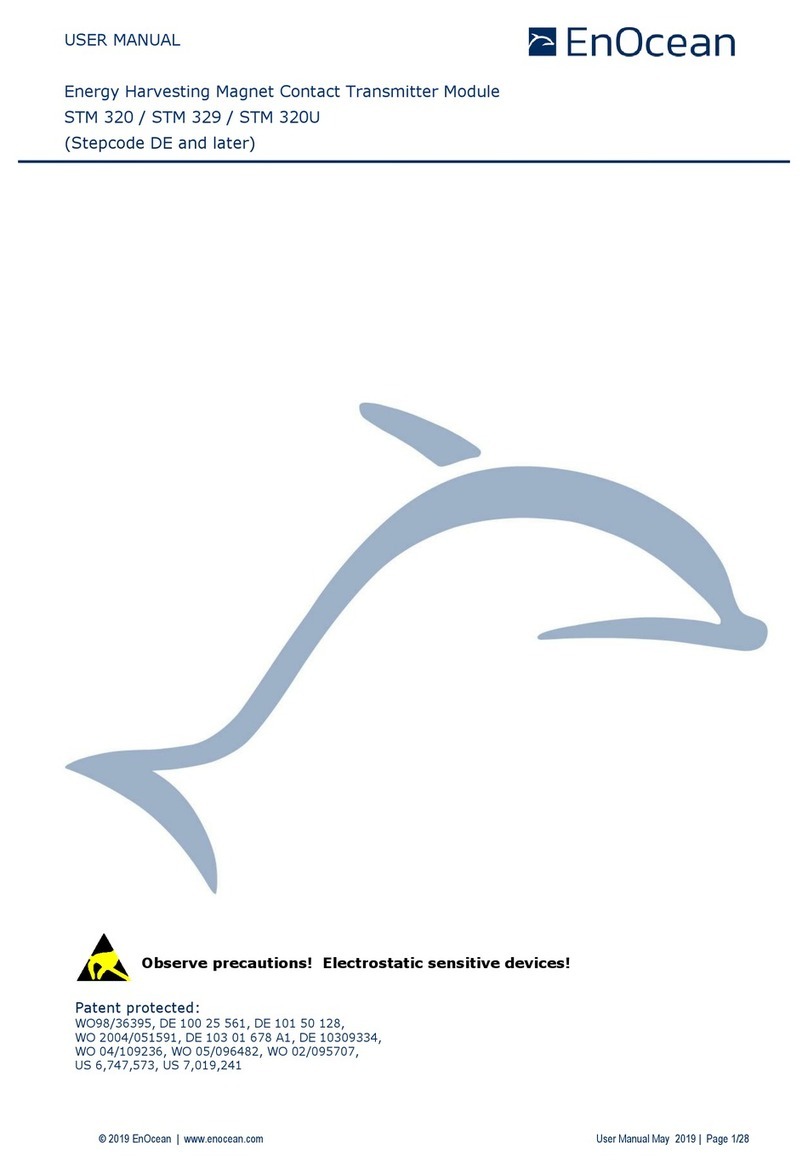
EnOcean
EnOcean STM 329 User manual
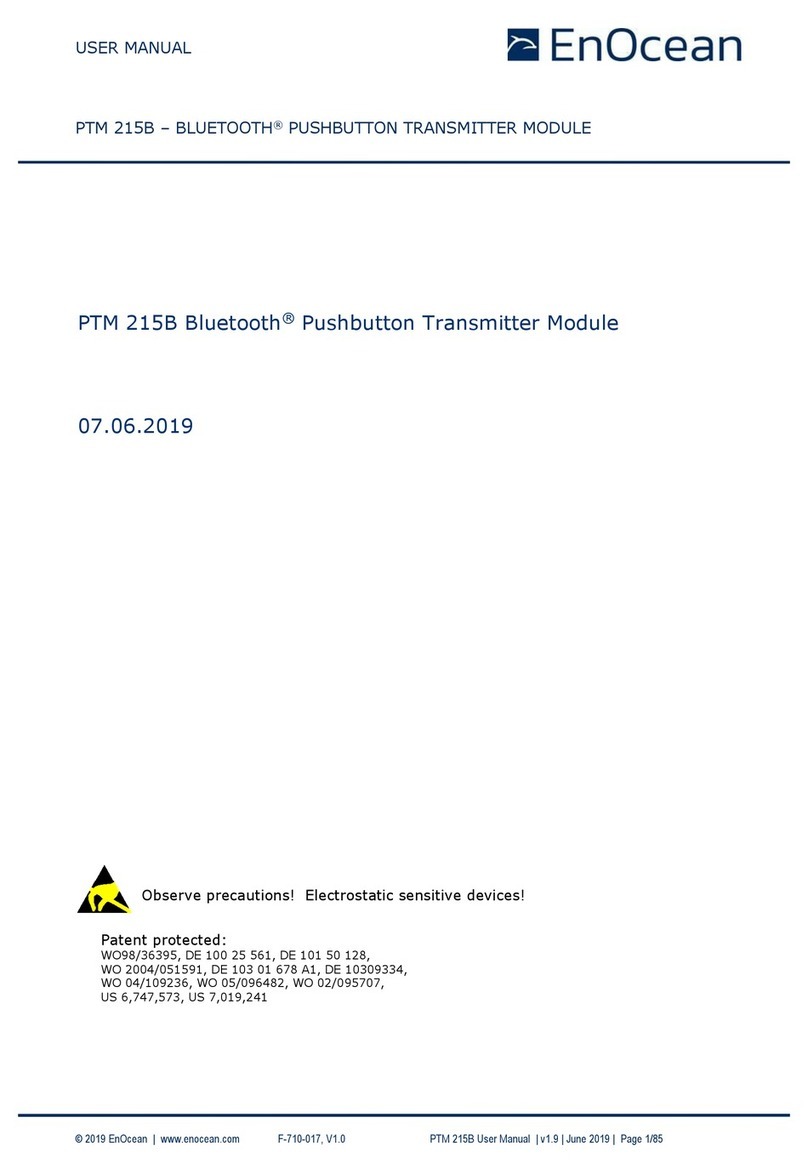
EnOcean
EnOcean PTM 215B User manual
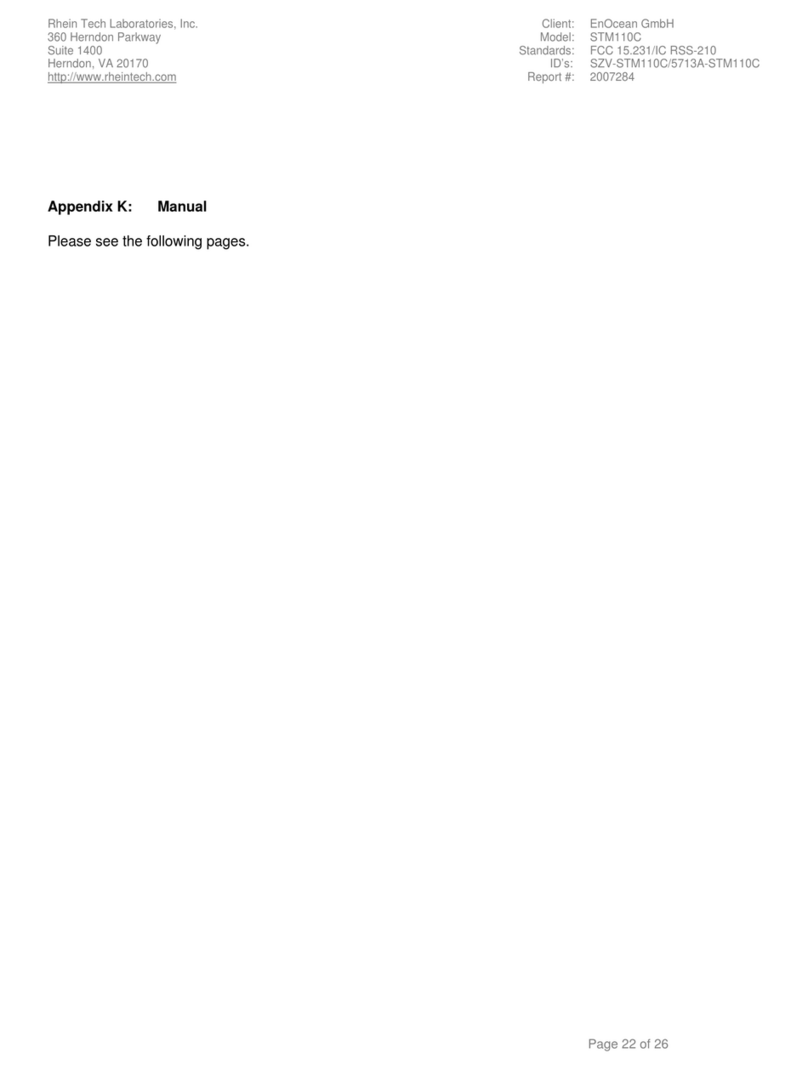
EnOcean
EnOcean STM110C User manual
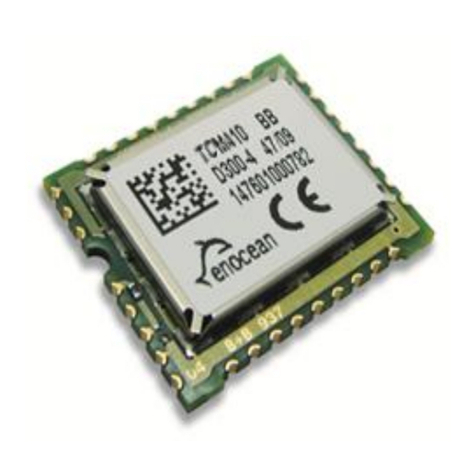
EnOcean
EnOcean TCM 410J User manual
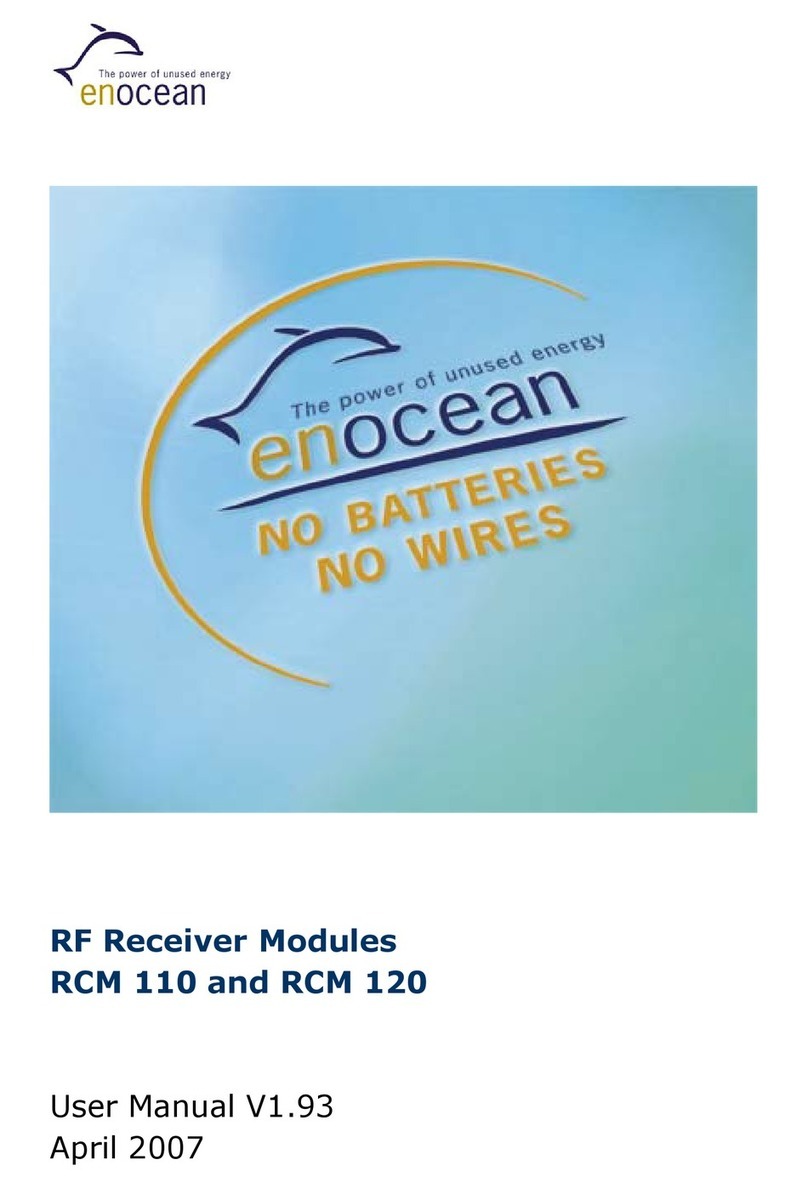
EnOcean
EnOcean RCM 110 User manual
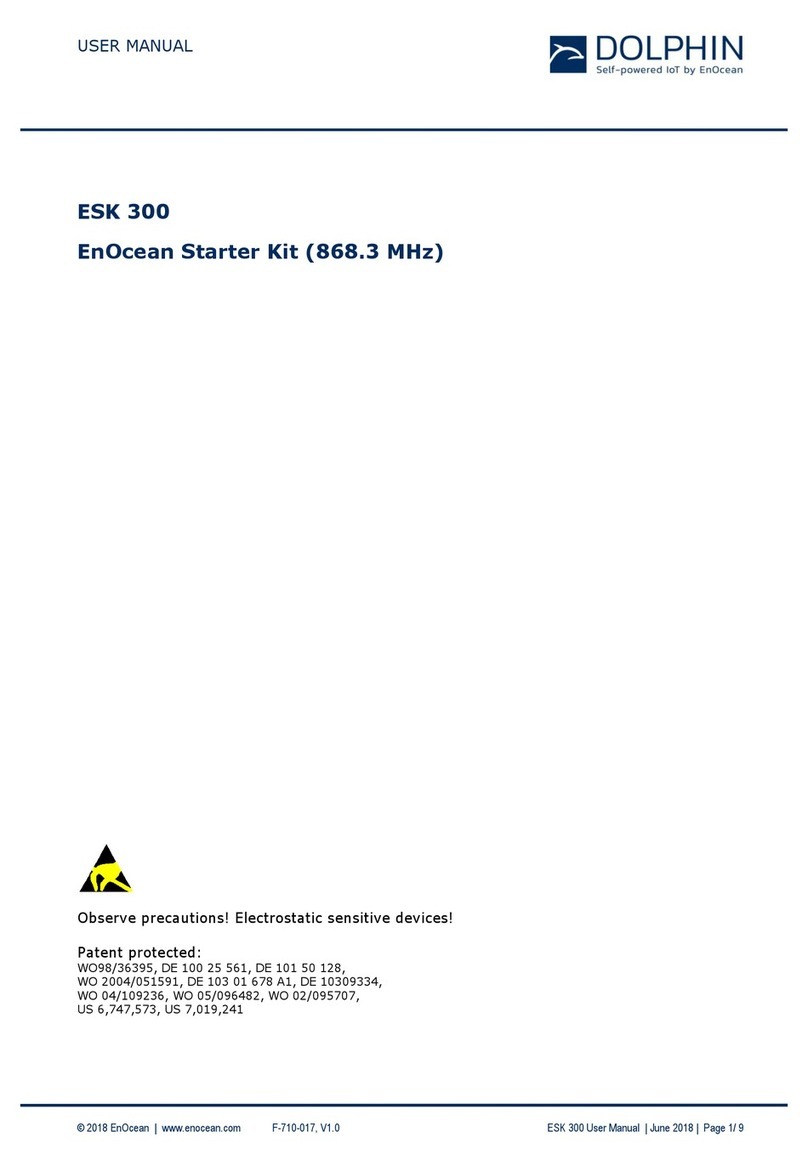
EnOcean
EnOcean ESK 300 User manual
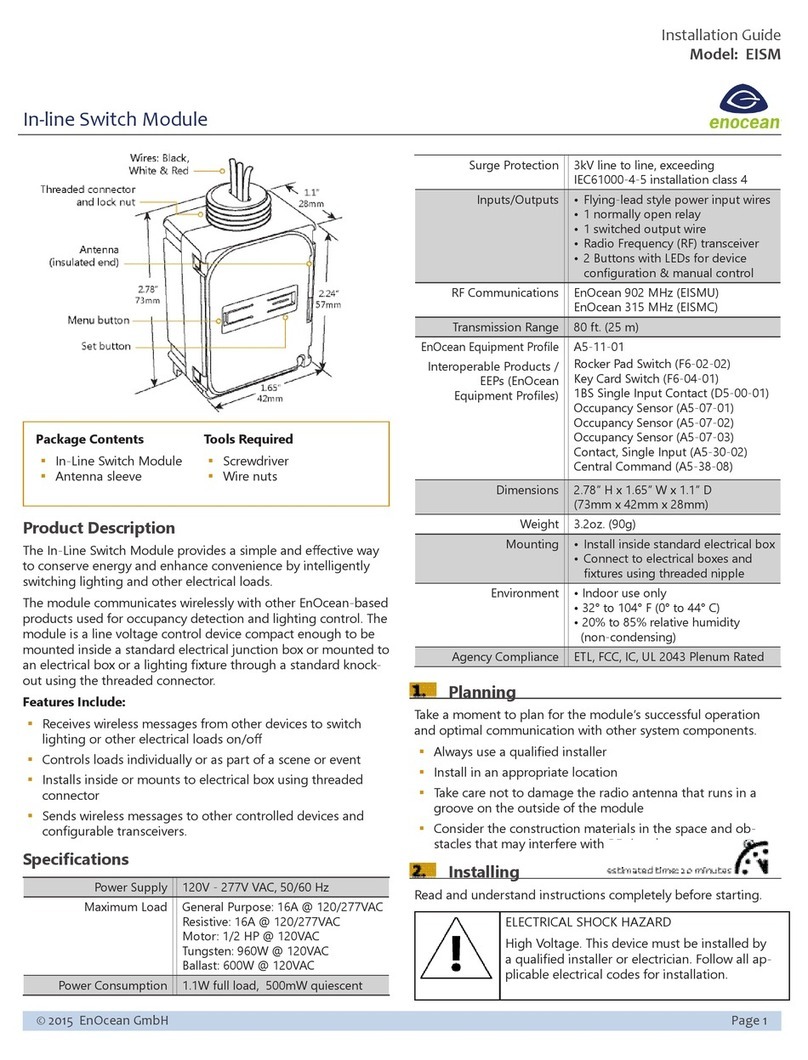
EnOcean
EnOcean EISM User manual

EnOcean
EnOcean STM 332U User manual
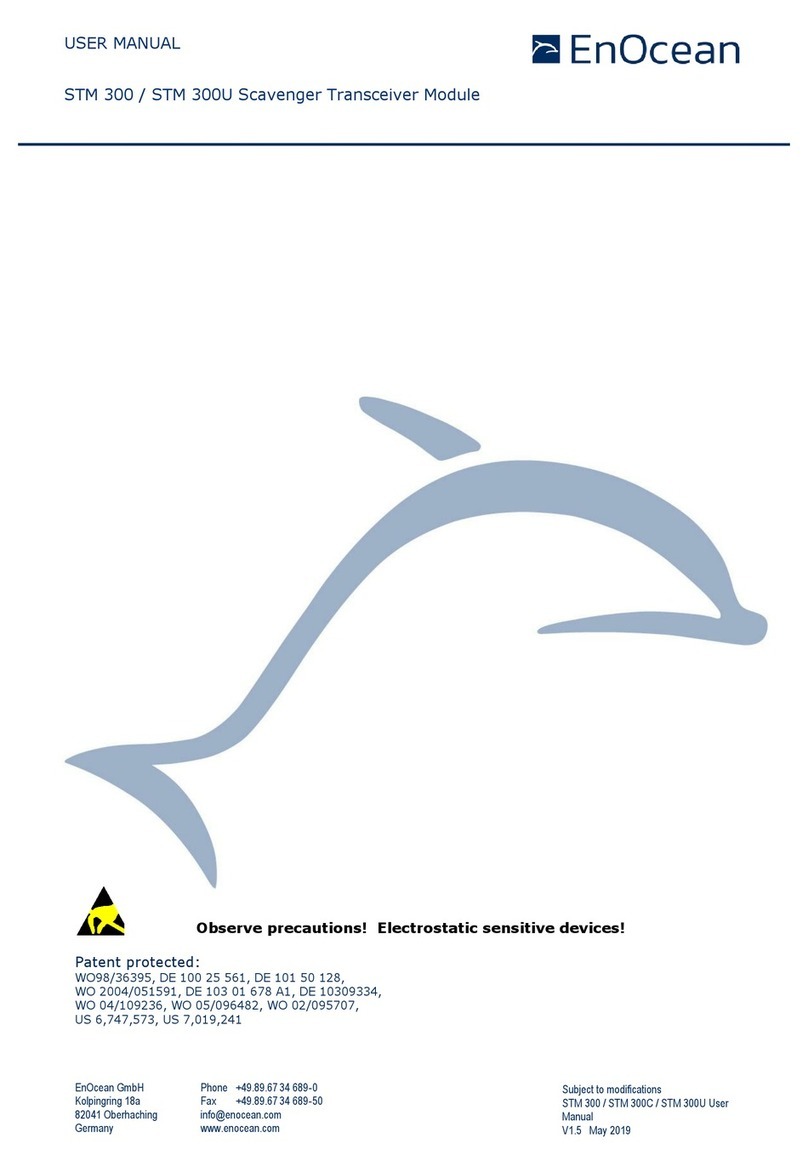
EnOcean
EnOcean STM 300U User manual
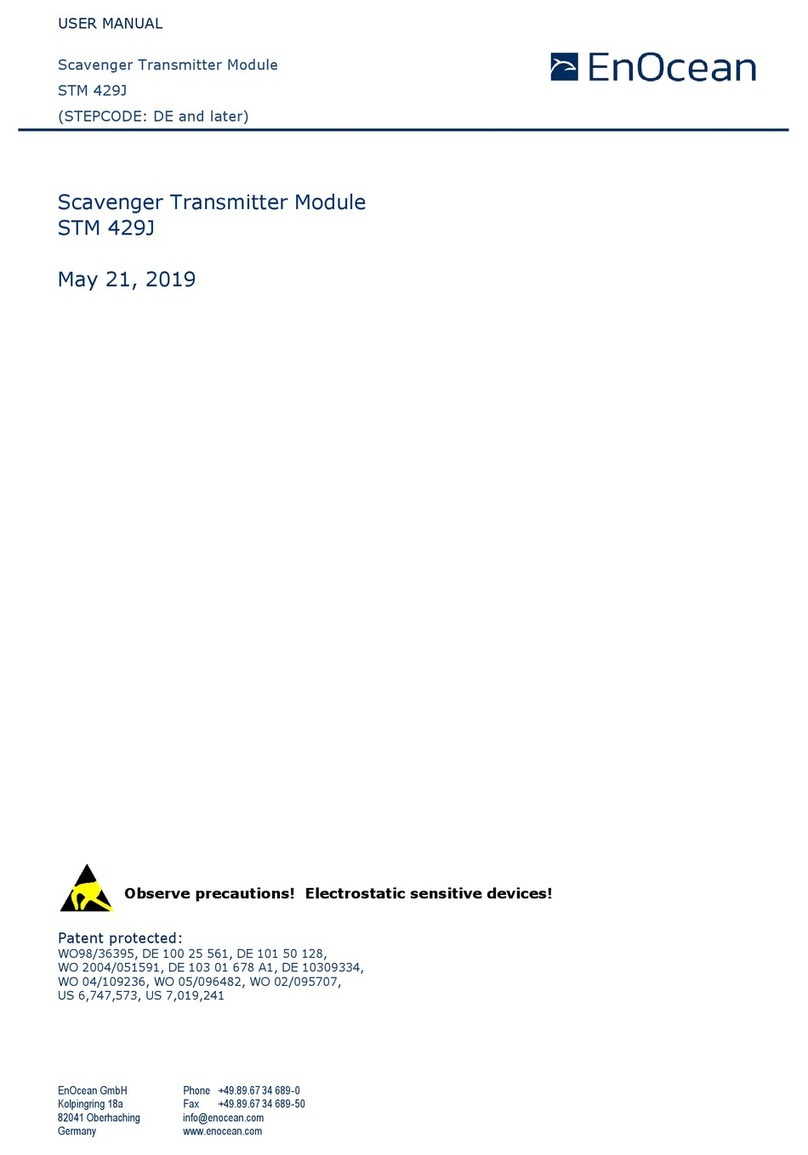
EnOcean
EnOcean Scavenger STM 429J User manual



